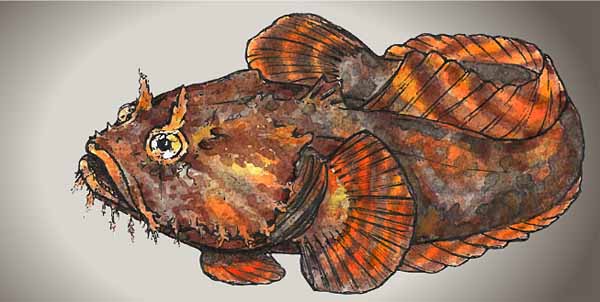Opsanus tau
(Linnaeus, 1766)
|
Familie: Batrachoididae SynonymeGadus tau Linnaeus, 1766 Lokale Bezeichnung |
Typen
Syntypen: LS 119 (linke halbe Haut), 120 [Garden no. 16] (rechte halbe Haut).
Typusfundort: Carolina [South Carolina, U.S.A.].
Etymologie
.
Verbreitung
Westlicher Atlantik.
IUCN Status

CR Critically Endangered (vom Aussterben bedroht)
EN Endangered (stark gefährdet)
VU Vulnerable (gefährdet)
NT Near Threatened (potenziell gefährdet)
LC Least Concern (nicht gefährdet)
RE Regionally Extinct (regional oder national ausgestorben)
DD Data Deficient (ungenügende Datengrundlage)
NE Not Evaluated (nicht beurteilt)
Status: Stand 2.03.2018: LC Least Concern (nicht gefährdet)
Grund für die Gefährdungseinstufung: Keine großen Gefährdungen für die Art bekannt.
Literatur
- Linnaeus, C. 1766. Systema naturae sive regna tria naturae, secundum classes, ordines, genera, species, cum characteribus, differentiis, synonymis, locis. Laurentii Salvii, Holmiae. 12th ed. 1 (1): 1-532. Zitatseite [: 439, !! als Gadus tau]
- Schöpf, J.D. 1788. Beschreibungen einiger nord-amerikanischer Fische, vorzüglich aus den neu-yorkischen Gewässern. Schriften der Berlinischen Gesellschaft Naturforschender Freunde, 8: 138-194.(PDF) Zitatseite [: 146, !! als Cottus glaber]
- Bloch, M.E. & Schneider, J.G. 1801. M. E. Blochii, Systema Ichthyologiae Iconibus cx Ilustratum. Post obitum auctoris opus inchoatum absolvit, correxit, interpolavit Jo. Gottlob Schneider, Saxo. Berolini. Sumtibus Auctoris Impressum et Bibliopolio Sanderiano Commissum i–lx + 1–584, Pls. 1–110. (BHL) Zitatseite [: 62, !! als Cottus chaetodon]
- Mitchill, S.L. 1815. The fishes of New-York, described and arranged. Transactions of the Literary and Philosophical Society of New-York, 1 (art. 5)[1814]: 355-492, Pls. 1-6.(BHL) Zitatseite [: 463, !! als Lophius bufo]
- Rafinesque, C.S. 1818. Description of three new genera of fluviatile fish, Pomoxis, Sarchirus and Exoglossum. Journal of the Academy of Natural Sciences, Philadelphia, 1 (2): 417-422, Pl. 17. BHL Zitatseite [: 204, !! als Opsanus cerapalus]
- Lesueur, C.A. 1824. Description of two new species of the genus Batrachoid of Lacepede. Journal of the Academy of Natural Sciences, Philadelphia, 3 (2): 395-403. (BHL) Zitatseite [: 395, !! als Batrachoides variegata]
- DeKay, J.E. 1842. Zoology of New-York, or the New-York fauna; comprising detailed descriptions of all the animals hitherto observed within the state of New-York, with brief notices of those occasionally found near its borders, and accompanied by appropriate illustrations. Part IV. Fishes. W. & A. White & J. Visscher, Albany. (als Teil von: Natural History of New York). i-xv + 1-415, Pls. 1-79. (BHL) Zitatseite [: 170, Pl. 50 (fig. 161), !! als Batrachus celatus]
- Dornburg, A., Warren, D.L., Zapfe, K.L. Morris, R., Iglesias, T.L., Lamb, A., Hogue, G., Lukas, L. & Wong, R. 2018. Testing ontogenetic patterns of sexual size dimorphism against expectations of the expensive tissue hypothesis, an intraspecific example using oyster toadfish (Opsanus tau). Ecology and Evolution, 2018;00:1–8. (doi) Zitatseite [: , Hintergrund sexueller Größenunterschiede]
